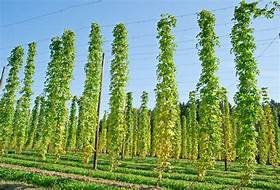I had
every intention of publishing a piece on the 2017 Herb of the Year – Cilantro/Coriander. Which didn’t happen. So, I’m going to take a quick step back to
2017. And, did you know …
An annual, Cilantro/Coriander is a favorite in many gardens.
It grows best in partial sun or as a
late fall/early spring plant (at least here – it doesn’t care too much for our summer heat and humidity) in a well-drained soil. The cilantro
leaves can be harvested when the plant has reached its mid-growth. It will flower with tiny fragrant pinkish white
blooms and then go to seed (Coriander). This a is two-for-one plant. If not picked for the seed, this plant is a
reseeder and will pop back up next spring.
This is one of the world’s oldest known herbs and has been
cultivated for over 3,000 years. The
ancient Egyptians believed coriander could be used in the afterlife as a food and
the seeds have been found in Egyptian tombs.
It is most often used in Mexican, Asian and East Indian
dishes. All parts of the plant are edible, but the fresh leaves and dried seeds
are most commonly used. The roots of the plant are an important ingredient in
Thai cooking where it is minced and used in salads, curries and relishes. The leaves are best used fresh as drying will
cause a loss of flavor. Add at the end
of the cooking time to maintain flavor. Leaves
are great to use with tomatoes and peppers for salsa, added to salads,
scrambled into eggs, included in guacamole, hummus, pesto sauce, fish, and
poultry dishes. The tender stems can be added to the water for flavoring
couscous. The seeds can be ground or
used whole in curry, chutney, marmalades, pies, cakes, breads, cookies, soups,
sauces and vegetable dishes.
Medicinally the essential oil can be added to ointment for
pain relief of joints and muscles. The leaves and seeds, used in a tea, have
digestive properties and stimulate appetite.
Carry a fresh spring of Cilantro in your pocket during a job
interview; it can help the interview be successful in obtaining a job. Bonus!
Cilantro/Coriander attracts beneficial insects like tachinid
flies, parasitoid wasps and hoverflies to your garden. And, it repels aphids, potato beetles and
spider mites. Double bonus!
And,
now, a step forward to 2018’s Herb of the Year - Hops
Everybody recognizes Hops – a flavoring and stability herb
used in beer making which gives it a bitter, zesty, and/or citric flavor. But, did you know, that hops have been used
in beer making since the 9th century. Prior to that, beer was made with bitter
herbs like dandelion, burdock, marigold, horehound, and ivy.
Hops are the flowers (also called seed cones) of the plant
Humulus lupulus. This plant is a
vigorous climbing perennial, usually trained to grow up strings in a hopfield, hop garden or hop yard. Pretty cool that they have their very own
name rather than just “the herb garden”.
But, hops can also be used in herbal medicine also. Similar to valerian, as a treatment for
anxiety, restlessness, and insomnia, a tea made with hops can bring relaxation
and calm. Though, you should remember that
hops is a bitter herb so you will need to add a sweetener like honey or agave nectar.
Fill a dream pillow with hops to
encourage pleasant dreams. Or, boil hops
flowers in water and use it as a cleaning agent to promote peace and relaxation
in a room.
Hops is a very attractive plant - it needs to grow on
something (rather than crawl all over the ground), is very aromatic, and has
many uses. What more could you want!
Growing hops is a little tricky as this plant is a vigorous
vine (or as one source calls it – a Bine
because “bines have significant stems with stiff
hairs that aid in their ability to climb while vines use suckers or tendrils to
attach themselves to surfaces” – ha! another bit of interesting moderately
useless information). They can grow up
to a food a day topping out at 25+feet.
They are grown from rootstock or rhizomes. Hops should be planted with a southern
exposure in a light, well-draining soil.
Plant the rhizomes as close together as 3 feet. Water consistently during the first year. Harvest the flowers in early fall when the
seed cones (flowers) feel dry-ish.
Take care.





No comments:
Post a Comment